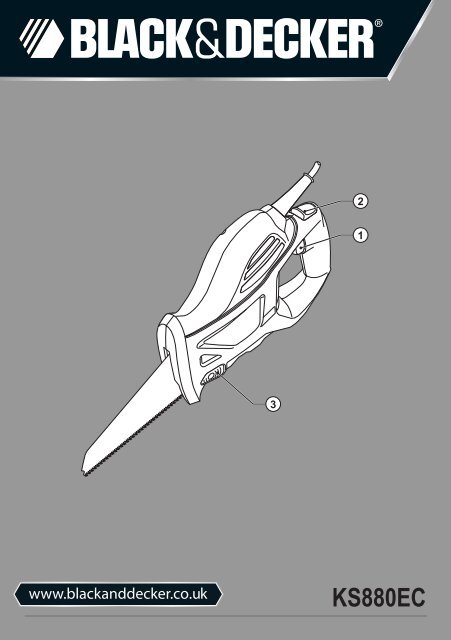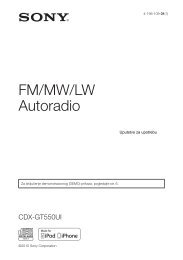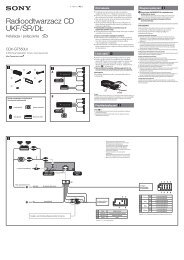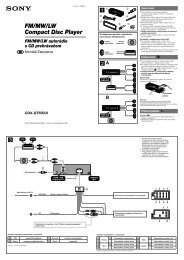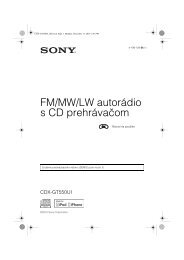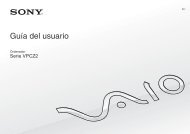BlackandDecker Scie De Decoupe- Ks880ec - Type 2 - Instruction Manual (Anglaise)
BlackandDecker Scie De Decoupe- Ks880ec - Type 2 - Instruction Manual (Anglaise)
BlackandDecker Scie De Decoupe- Ks880ec - Type 2 - Instruction Manual (Anglaise)
Create successful ePaper yourself
Turn your PDF publications into a flip-book with our unique Google optimized e-Paper software.
KS880EC
English (Original instructions) 4<br />
2
A<br />
B<br />
C<br />
D<br />
E<br />
3
Intended use<br />
Your Black & <strong>De</strong>cker saw has been designed for sawing<br />
wood, plastics and metal. This tool is intended for consumer<br />
use only.<br />
Safety instructions<br />
General power tool safety warnings<br />
@<br />
4<br />
Warning! Read all safety warnings and all<br />
instructions. Failure to follow the warnings and<br />
instructions listed below may result in electric shock,<br />
fire and/or serious injury.<br />
Save all warnings and instructions for future reference.<br />
The term "power tool" in all of the warnings listed below refers<br />
to your mains operated (corded) power tool or battery<br />
operated (cordless) power tool.<br />
1. Work area safety<br />
a. Keep work area clean and well lit. Cluttered or dark<br />
areas invite accidents.<br />
b. Do not operate power tools in explosive atmospheres,<br />
such as in the presence of flammable liquids, gases<br />
or dust. Power tools create sparks which may ignite the<br />
dust or fumes.<br />
c. Keep children and bystanders away while operating<br />
a power tool. Distractions can cause you to lose control.<br />
2. Electrical safety<br />
a. Power tool plugs must match the outlet. Never modify<br />
the plug in any way. Do not use any adapter plugs<br />
with earthed (grounded) power tools. Unmodified plugs<br />
and matching outlets will reduce risk of electric shock.<br />
b. Avoid body contact with earthed or grounded<br />
surfaces such as pipes, radiators, ranges and<br />
refrigerators. There is an increased risk of electric shock<br />
if your body is earthed or grounded.<br />
c. Do not expose power tools to rain or wet conditions.<br />
Water entering a power tool will increase the risk of<br />
electric shock.<br />
d. Do not abuse the cord. Never use the cord for carrying,<br />
pulling or unplugging the power tool. Keep cord away<br />
from heat, oil, sharp edges or moving parts. Damaged<br />
or entangled cords increase the risk of electric shock.<br />
e. When operating a power tool outdoors, use an<br />
extension cord suitable for outdoor use. Use of a cord<br />
suitable for outdoor use reduces the risk of electric shock.<br />
f. If operating a power tool in a damp location is<br />
unavoidable, use a residual current device (RCD)<br />
protected supply. Use of an RCD reduces the risk of<br />
electric shock.<br />
3. Personal safety<br />
a. Stay alert, watch what you are doing and use common<br />
sense when operating a power tool. Do not use a power<br />
tool while you are tired or under the influence of drugs,<br />
alcohol or medication. A moment of inattention while<br />
operating power tools may result in serious personal injury.<br />
b. Use personal protective equipment. Always wear eye<br />
protection. Protective equipment such as dust mask,<br />
non-skid safety shoes, hard hat, or hearing protection used<br />
for appropriate conditions will reduce personal injuries.<br />
c. Prevent unintentional starting. Ensure the switch is in<br />
the off-position before connecting to power source<br />
and/or battery pack, picking up or carrying the tool.<br />
Carrying power tools with your finger on the switch or<br />
energising power tools that have the switch on invites<br />
accidents.<br />
d. Remove any adjusting key or wrench before turning<br />
the power tool on. A wrench or a key left attached to a<br />
rotating part of the power tool may result in personal injury.<br />
e. Do not overreach. Keep proper footing and balance at<br />
all times. This enables better control of the power tool in<br />
unexpected situations.<br />
f. Dress properly. Do not wear loose clothing or<br />
jewellery. Keep your hair, clothing and gloves away<br />
from moving parts. Loose clothes, jewellery or long hair<br />
can be caught in moving parts.<br />
g. If devices are provided for the connection of dust<br />
extraction and collection facilities, ensure these are<br />
connected and properly used. Use of dust collection can<br />
reduce dust-related hazards.<br />
4. Power tool use and care<br />
a. Do not force the power tool. Use the correct power<br />
tool for your application. The correct power tool will do<br />
the job better and safer at the rate for which it was designed.<br />
b. Do not use the power tool if the switch does not turn it<br />
on and off. Any power tool that cannot be controlled with<br />
the switch is dangerous and must be repaired.<br />
c. Disconnect the plug from the power source and/or the<br />
battery pack from the power tool before making any<br />
adjustments, changing accessories, or storing power<br />
tools. Such preventive safety measures reduce the risk of<br />
starting the power tool accidentally.<br />
d. Store idle power tools out of the reach of children and<br />
do not allow persons unfamiliar with the power tool or<br />
these instructions to operate the power tool. Power<br />
tools are dangerous in the hands of untrained users.<br />
e. Maintain power tools. Check for misalignment or<br />
binding of moving parts, breakage of parts and any<br />
other condition that may affect the power tools<br />
operation. If damaged, have the power tool repaired<br />
before use. Many accidents are caused by poorly<br />
maintained power tools.
f. Keep cutting tools sharp and clean. Properly<br />
maintained cutting tools with sharp cutting edges are less<br />
likely to bind and are easier to control.<br />
g. Use the power tool, accessories and tool bits etc. in<br />
accordance with these instructions, taking into<br />
account the working conditions and the work to be<br />
performed. Use of the power tool for operations different<br />
from those intended could result in a hazardous situation.<br />
5. Service<br />
a. Have your power tool serviced by a qualified repair<br />
person using only identical replacement parts. This will<br />
ensure that the safety of the power tool is maintained.<br />
Additional power tool safety warnings<br />
@<br />
Warning! Additional safety warnings for jigsaws and<br />
reciprocating saws<br />
u Hold the tool by the insulated gripping surfaces when<br />
performing an operation where the cutting tool may<br />
contact hidden wiring or its own cord. Cutting<br />
accessory contacting a "live" wire may make exposed<br />
metal parts of the power tool "live" and shock the operator.<br />
u Use clamps or another practical way to secure and<br />
support the workpiece to a stable platform. Holding the<br />
work by hand or against your body leaves it unstable and<br />
may lead to loss of control.<br />
u Keep hands away from cutting area. Never reach<br />
underneath the work piece for any reason. Do not insert<br />
fingers or thumb into the vicinity of the reciprocating blade<br />
and blade clamp. Do not stabilize the saw by gripping the<br />
shoe.<br />
u Keep blades sharp. Dull or damaged blades may cause<br />
the saw to swerve or stall under pressure. Always use the<br />
appropriate type of saw blade for the workpiece material<br />
and type of cut.<br />
u When cutting pipe or conduit, make sure that they are free<br />
from water, electrical wiring, etc.<br />
u Do not touch the workpiece or the blade immediately after<br />
operating the tool. They can become very hot.<br />
u Be aware of hidden hazards, before cutting into walls,<br />
floors or ceilings, check for the location of wiring and pipes.<br />
u The blade will continue to move after releasing the switch.<br />
Always switch the tool off and wait for the saw blade to<br />
come to a complete standstill before putting the tool down.<br />
u Warning! Contact with, or inhalation of dusts arising from<br />
cutting applications may endanger the health of the<br />
operator and possible bystanders. Wear a dust mask<br />
specifically designed for protection against dust and fumes<br />
and ensure that persons within or entering the work area<br />
are also protected.<br />
u The intended use is described in this instruction manual.<br />
The use of any accessory or attachment or performance<br />
of any operation with this tool other than those<br />
recommended in this instruction manual may present<br />
a risk of personal injury and/or damage to property.<br />
Safety of others<br />
u This appliance is not intended for use by persons<br />
(including children) with reduced physical, sensory or<br />
mental capabilities, or lack of experience and knowledge,<br />
unless they have been given supervision or instruction<br />
concerning use of the appliance by a person responsible<br />
for their safety.<br />
u Children should be supervised to ensure that they do not<br />
play with the appliance.<br />
Vibration<br />
The declared vibration emission values stated in the technical<br />
data and the declaration of conformity have been measured in<br />
accordance with a standard test method provided by<br />
EN 60745 and may be used for comparing one tool with<br />
another. The declared vibration emission value may also be<br />
used in a preliminary assessment of exposure.<br />
Warning! The vibration emission value during actual use of<br />
the power tool can differ from the declared value depending<br />
on the ways in which the tool is used. The vibration level may<br />
increase above the level stated.<br />
When assessing vibration exposure to determine safety<br />
measures required by 2002/44/EC to protect persons regularly<br />
using power tools in employment, an estimation of vibration<br />
exposure should consider, the actual conditions of use and the<br />
way the tool is used, including taking account of all parts of the<br />
operating cycle such as the times when the tool is switched off<br />
and when it is running idle in addition to the trigger time.<br />
Labels on tool<br />
The following pictograms are shown on the tool:<br />
:<br />
Warning! To reduce the risk of injury, the user must<br />
read the instruction manual.<br />
Electrical safety<br />
#<br />
This tool is double insulated; therefore no earth wire<br />
is required. Always check that the power supply<br />
corresponds to the voltage on the rating plate.<br />
u If the supply cord is damaged, it must be replaced by the<br />
manufacturer or an authorised Black & <strong>De</strong>cker Service<br />
Centre in order to avoid a hazard.<br />
5
Features<br />
This tool includes some or all of the following features.<br />
1. Variable speed switch<br />
2. Lock-off button<br />
3. Blade release button<br />
Fig. A<br />
4. Large capacity blade<br />
Assembly<br />
Warning! Before assembly, make sure that the tool is<br />
switched off and unplugged.<br />
Fitting and removing a saw blade (fig. B & C)<br />
Fitting<br />
u Place the blade over the location pin (5).<br />
u Rotate the blade upward through 90° until it is fully located<br />
in the saw blade slot (6) and the location pin is in the<br />
locked position.<br />
u Make sure the blade is securely fitted by trying to remove<br />
it without depressing the blade release button (3).<br />
If you are unable to fit the blade, check if the location pin is in<br />
the correct position as shown in fig. C. If it is not, keep the<br />
blade release button depressed and use a screwdriver to turn<br />
the location pin into the correct position.<br />
Removing<br />
u Keep the blade release button (3) depressed and rotate<br />
the blade downward through 90°.<br />
u Take the blade sideways off the location pin and slide it<br />
out of the tool.<br />
u Release the blade release button.<br />
Residual risks.<br />
Additional residual risks may arise when using the tool which<br />
may not be included in the enclosed safety warnings. These<br />
risks can arise from misuse, prolonged use etc.<br />
Even with the application of the relevant safety regulations<br />
and the implementation of safety devices, certain residual<br />
risks can not be avoided. These include:<br />
u Injuries caused by touching any rotating/moving<br />
parts.<br />
u Injuries caused when changing any parts, blades or<br />
accessories.<br />
u Injuries caused by prolonged use of a tool. When<br />
using any tool for prolonged periods ensure you take<br />
regular breaks.<br />
u Impairment of hearing.<br />
u Health hazards caused by breathing dust developed<br />
when using your tool (example:- working with wood,<br />
especially oak, beech and MDF.)<br />
Use<br />
Warning! Let the tool work at its own pace. Do not overload.<br />
u Do not touch the saw blade immediately after the<br />
operation as it might be hot.<br />
Switching on and off (fig. D)<br />
u To switch the tool on, push the two lock-off button (2) into<br />
the unlock position and squeeze the variable speed switch<br />
(1).<br />
u To switch the tool off, release the variable speed switch.<br />
Sawing (fig. E)<br />
u If possible, always hold the tool with both hands.<br />
u Let the blade run freely for a few seconds before starting<br />
the cut.<br />
u Apply only a gentle pressure to the tool while performing<br />
the cut.<br />
u Use the same back and forth movement you would<br />
employ with a normal hand saw. This enables a quicker<br />
and cleaner cut.<br />
Hints for optimum use<br />
Sawing wood<br />
u Fit a large capacity blade (4).<br />
u Clamp the workpiece securely and remove all nails and<br />
metal objects.<br />
u When splintering is to be minimised, e.g. when cutting<br />
laminates, clamp a piece of scrap wood or hardboard to<br />
both sides of the workpiece and saw through this<br />
sandwich.<br />
Sawing metal<br />
u Be aware that sawing metal takes much more time than<br />
sawing wood.<br />
u Fit a metal cutting blade.<br />
u When cutting thin sheet metal, clamp a piece of scrap<br />
wood to the back surface of the workpiece and cut through<br />
this sandwich.<br />
u Spread a film of oil along the intended line of cut.<br />
Maintenance<br />
Your Black & <strong>De</strong>cker corded/cordless appliance/tool has been<br />
designed to operate over a long period of time with a minimum<br />
of maintenance. Continuous satisfactory operation depends<br />
upon proper tool care and regular cleaning.<br />
Warning! Before performing any maintenance on corded/<br />
cordless power tools:<br />
u Switch off and unplug the appliance/tool.<br />
u Or switch off and remove the battery from the appliance/<br />
tool if the appliance/tool has a separate battery pack.<br />
6
u Or run the battery down completely if it is integral and then<br />
switch off.<br />
u Unplug the charger before cleaning it. Your charger does<br />
not require any maintenance apart from regular cleaning.<br />
u Regularly clean the ventilation slots in your appliance/tool/<br />
charger using a soft brush or dry cloth.<br />
u Regularly clean the motor housing using a damp cloth.<br />
Do not use any abrasive or solvent-based cleaner.<br />
u Regularly open the chuck and tap it to remove any dust<br />
from the interior (when fitted).<br />
Mains plug replacement (U.K. & Ireland only)<br />
If a new mains plug needs to be fitted:<br />
u Safely dispose of the old plug.<br />
u Connect the brown lead to the live terminal in the new plug.<br />
u Connect the blue lead to the neutral terminal.<br />
Warning! No connection is to be made to the earth terminal.<br />
Follow the fitting instructions supplied with good quality plugs.<br />
Recommended fuse: 5 A.<br />
Protecting the environment<br />
Separate collection. This product must not be<br />
disposed of with normal household waste.<br />
Should you find one day that your Black & <strong>De</strong>cker product<br />
needs replacement, or if it is of no further use to you, do not<br />
dispose of it with household waste. Make this product<br />
available for separate collection.<br />
z<br />
Separate collection of used products and packaging<br />
allows materials to be recycled and used again.<br />
Re-use of recycled materials helps prevent<br />
environmental pollution and reduces the demand for<br />
raw materials.<br />
Local regulations may provide for separate collection of<br />
electrical products from the household, at municipal waste<br />
sites or by the retailer when you purchase a new product.<br />
Black & <strong>De</strong>cker provides a facility for the collection and<br />
recycling of Black & <strong>De</strong>cker products once they have reached<br />
the end of their working life. To take advantage of this service<br />
please return your product to any authorised repair agent who<br />
will collect them on our behalf.<br />
Technical data<br />
KS880EC TYPE 2<br />
Input voltage V AC 230<br />
Power input W 400<br />
Number of strokes min -1 0 - 4,600<br />
Stroke length mm 10<br />
Max. depth of cut<br />
mm<br />
Wood 100<br />
Steel 3<br />
Plastic pipe ø 50<br />
Weight kg 1.9<br />
Level of sound pressure according to EN 60745:<br />
Sound pressure (L pA<br />
) 84 dB(A), uncertainty (K) 3 dB(A)<br />
Sound power (L WA<br />
) 95 dB(A), uncertainty (K) 3 dB(A)<br />
Vibration total values (triax vector sum) according to EN 60745:<br />
Cutting wood (a h, cw<br />
) 17.1 m/s 2 , uncertainty (K) 2.5 m/s 2<br />
Cutting sheet metal (a h, cm<br />
) 10.3 m/s 2 , uncertainty (K) 2.4 m/s 2<br />
EC declaration of conformity<br />
MACHINERY DIRECTIVE<br />
%<br />
KS880EC<br />
Black & <strong>De</strong>cker declares that these products described under<br />
"technical data" are in compliance with:<br />
2006/42/EC , EN 60745-1, EN 60745-2-11<br />
For more information, please contact Black & <strong>De</strong>cker at the<br />
following address or refer to the back of the manual.<br />
The undersigned is responsible for compilation of the technical<br />
file and makes this declaration on behalf of Black & <strong>De</strong>cker.<br />
_<br />
Kevin Hewitt<br />
Vice-President Global Engineering<br />
Black & <strong>De</strong>cker Europe, 210 Bath Road, Slough,<br />
Berkshire, SL1 3YD<br />
United Kingdom<br />
20-01-2010<br />
You can check the location of your nearest authorised repair<br />
agent by contacting your local Black & <strong>De</strong>cker office at the<br />
address indicated in this manual. Alternatively, a list of<br />
authorised Black & <strong>De</strong>cker repair agents and full details of our<br />
after-sales service and contacts are available on the Internet<br />
at: www.2helpU.com<br />
7
Guarantee<br />
Black & <strong>De</strong>cker is confident of the quality of its products and<br />
offers an outstanding guarantee. This guarantee statement is<br />
in addition to and in no way prejudices your statutory rights.<br />
The guarantee is valid within the territories of the Member<br />
States of the European Union and the European Free Trade<br />
Area.<br />
If a Black & <strong>De</strong>cker product becomes defective due to faulty<br />
materials, workmanship or lack of conformity, within 24 months<br />
from the date of purchase, Black & <strong>De</strong>cker guarantees to<br />
replace defective parts, repair products subjected to fair wear<br />
and tear or replace such products to ensure minimum<br />
inconvenience to the customer unless:<br />
u The product has been used for trade, professional or hire<br />
purposes;<br />
u The product has been subjected to misuse or neglect;<br />
u The product has sustained damage through foreign<br />
objects, substances or accidents;<br />
u Repairs have been attempted by persons other than<br />
authorised repair agents or Black & <strong>De</strong>cker service staff.<br />
To claim on the guarantee, you will need to submit proof of<br />
purchase to the seller or an authorised repair agent. You can<br />
check the location of your nearest authorised repair agent by<br />
contacting your local Black & <strong>De</strong>cker office at the address<br />
indicated in this manual. Alternatively, a list of authorised<br />
Black & <strong>De</strong>cker repair agents and full details of our after-sales<br />
service and contacts are available on the Internet at:<br />
www.2helpU.com<br />
Please visit our website www.blackanddecker.co.uk to<br />
register your new Black & <strong>De</strong>cker product and to be kept up to<br />
date on new products and special offers. Further information<br />
on the Black & <strong>De</strong>cker brand and our range of products is<br />
available at www.blackanddecker.co.uk<br />
8
9
TYP.<br />
KS880EC 2<br />
GB<br />
150<br />
139<br />
130<br />
129<br />
140<br />
147<br />
151<br />
143<br />
142<br />
131<br />
131<br />
141<br />
125<br />
126<br />
127<br />
128 121<br />
122<br />
102<br />
130<br />
124<br />
132<br />
146<br />
101<br />
138<br />
105<br />
104<br />
106<br />
108<br />
105<br />
110<br />
118<br />
800<br />
112<br />
111<br />
113<br />
148<br />
108<br />
109<br />
114<br />
115<br />
117<br />
116<br />
E15952<br />
www.2helpU.com 20 - 01 - 10
ENGLISH<br />
Do not forget to register your product!<br />
www.blackanddecker.co.uk/productregistration<br />
Register your product online at www.blackanddecker.co.uk/productregistration or send your name, surname and product<br />
code to Black & <strong>De</strong>cker in your country.
Australia<br />
Black & <strong>De</strong>cker (Australia) Pty. Ltd. Tel. 03-8720 5100<br />
20 Fletcher Road, Mooroolbark, Fax 03-9727 5940<br />
Victoria, 3138<br />
New Zealand<br />
Black & <strong>De</strong>cker Tel. +64 9 259 1133<br />
5 Te Apunga Place Fax +64 9 259 1122<br />
Mt Wellington<br />
Auckland 1060<br />
United Kingdom<br />
Black & <strong>De</strong>cker Tel. 01753 511234<br />
210 Bath Road Fax 01753 551155<br />
Slough, Berkshire SL1 3YD Helpline 01753 574277<br />
90556145 REV-0 01/2010


